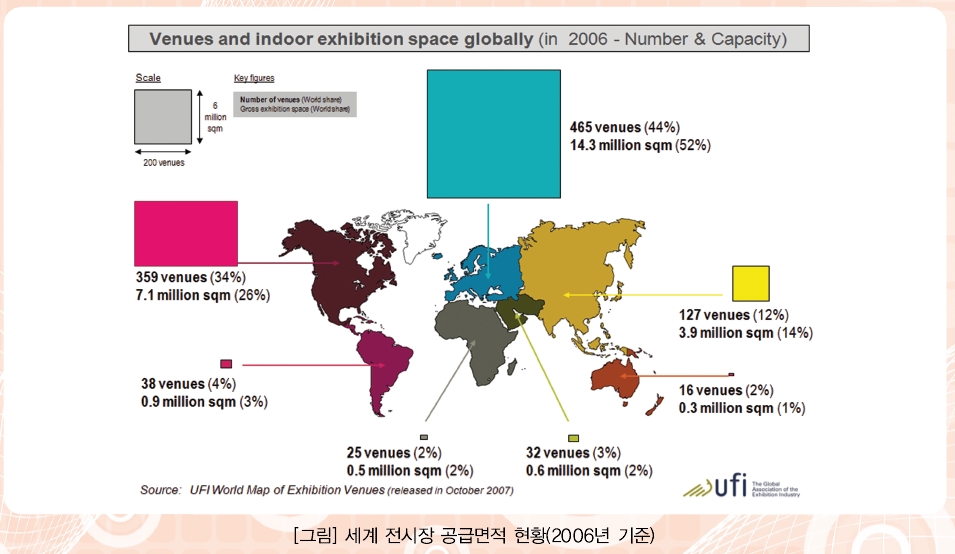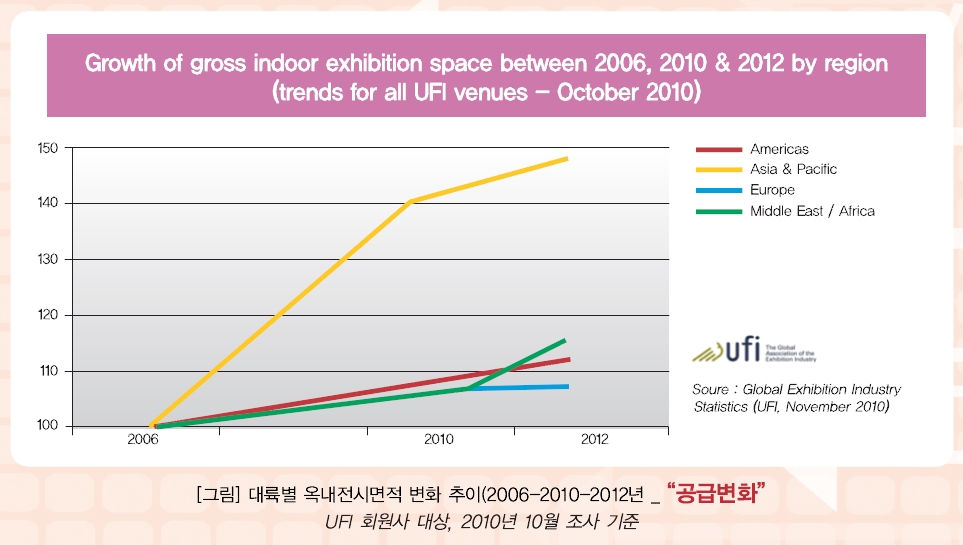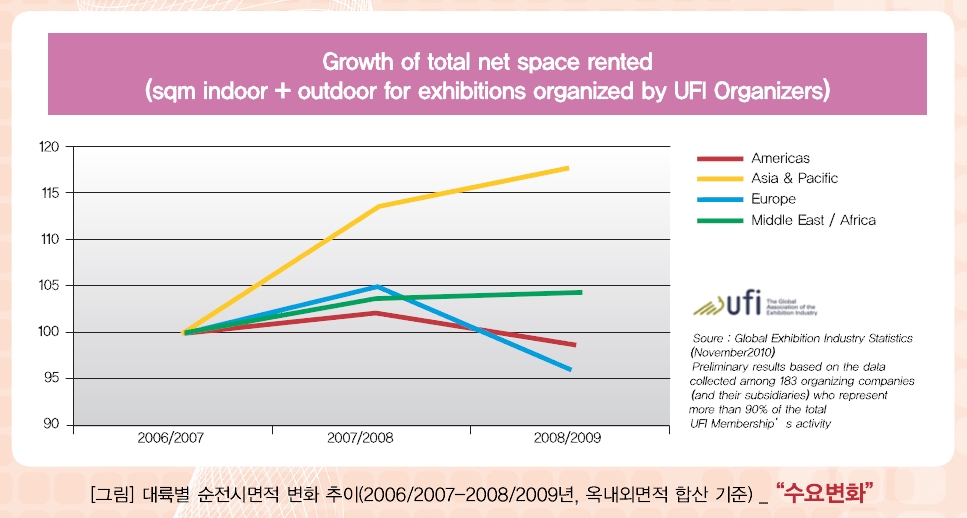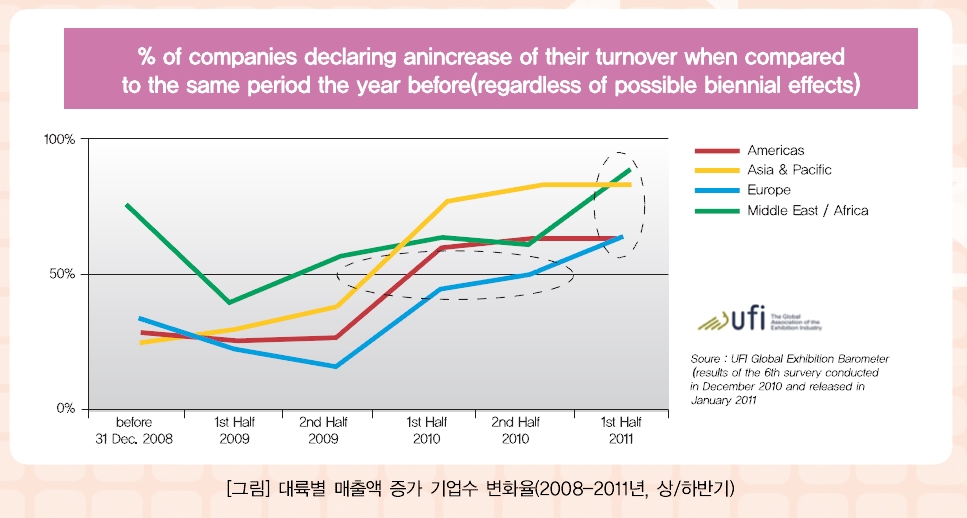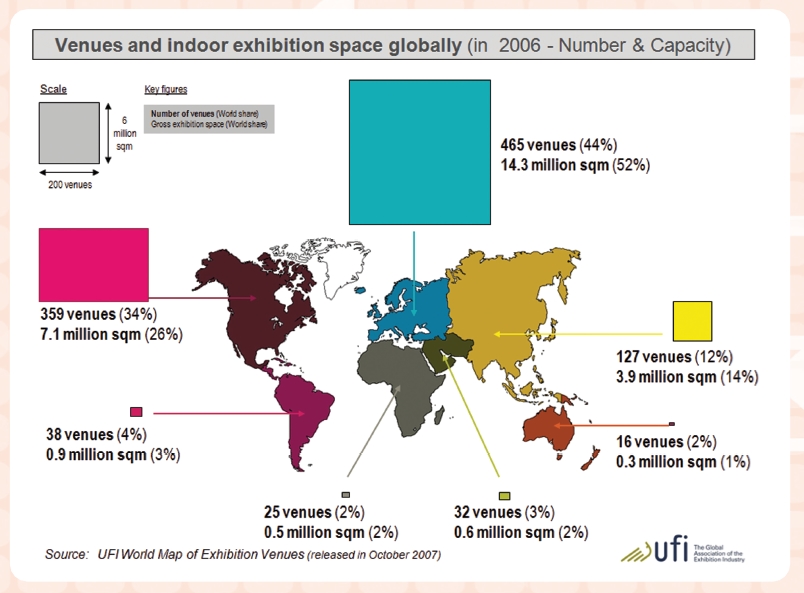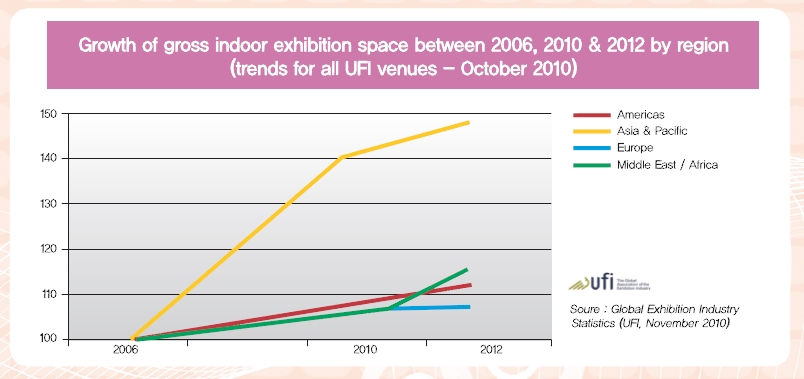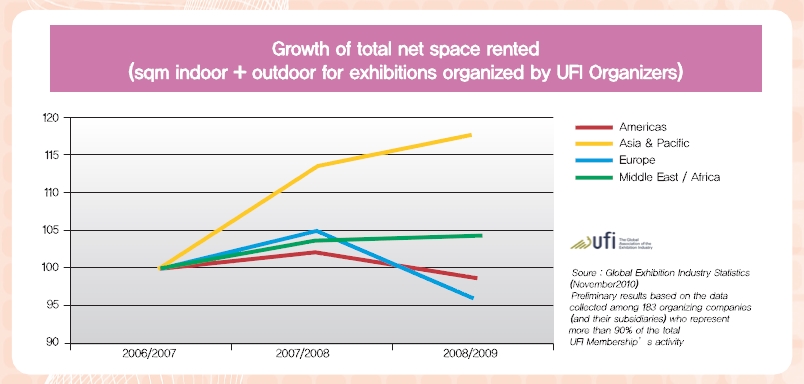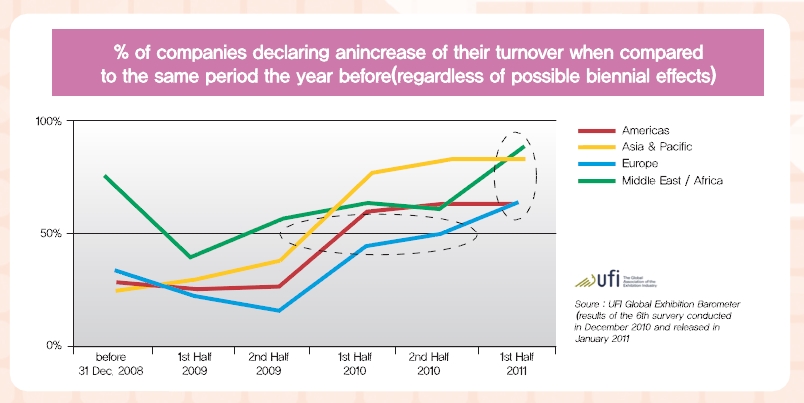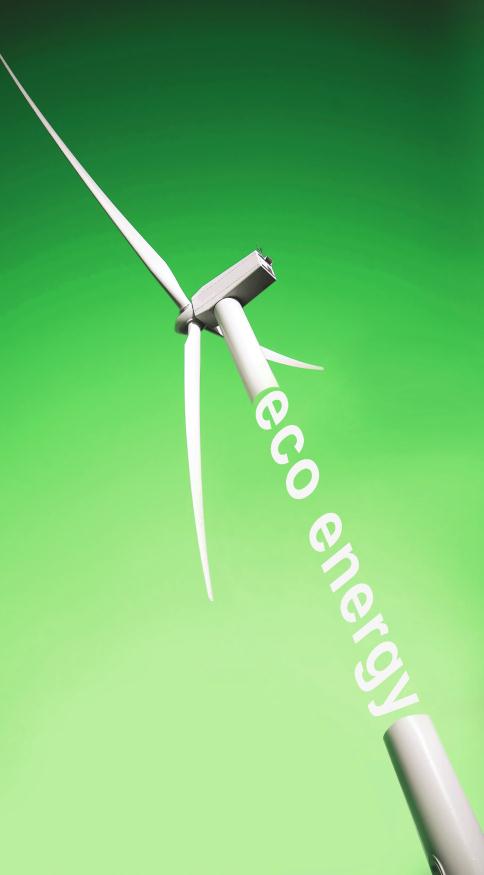
세계전시산업협회 UFI는 정기적으로 전시산업의 수요, 공급 부문에 대한 시장조사를 실시하고, 이를 토대로 글로벌 전시산업의 동향 및 이슈에 대한 분석연구를 수행하고 있다. 특히 지난 2008년 세계금융위기 이후불안정한 세계경제의 흐름과 이의 영향을 받는 전시산업에 관한 과학적인 근거가 요구됨에 따라 이와 관련한데이터를 파악하는 일이 무엇보다도 중요해지고 있다. 이에 본 지에서는 UFI 리서치매니저 크리스티앙 드루아트(Christian Druart)로부터 세계 전시산업 현황 및 전망지표에 대해 들어보았다.
 크리스티앙 드루아트 (Christian Druart)
크리스티앙 드루아트 (Christian Druart)
크리스티앙 드루아트는 세계전시산업협회 UFI(Global Association of theExhibition Industry)의 리서치매니저로, UFI 지속가능한 개발 위원회의 위원장을겸직하고 있다. 그는 ISO 20121 프로젝트 위원회 및 GRI EOSS 자문위원으로도 활약 중인 그는 Ecole Centrale de Nantes 대학에서 엔지니어링(Engineering) 학사과정을 마치고, Conservatoire National des Arts et M?tiers (프랑스 소재)에서조직학(Organization) 석사 학위를 받았다.
크리스티앙은 UFI에서 근무하기 이전에 런던 소재 주영 프랑스대사관에서 근무하고, Price Waterhouse사에서 컨설턴트로 일했으며, 파리상공회의소(ParisChamber of Commerce) 회의전시부(Congress & Exhibition department) 의사무관을 역임했다.
UFI 통계분석보고서를 통해 살펴본 세계 전시산업 현황 및 전망지표
■ 연구배경(Background)
세계전시산업협회(Global Association of theExhibition Industry, 이하 UFI)는 회원기관 및 전시산업관련일반공동체에게세계전시시장과관련한신뢰성있는 데이터를 제공하기 위한 목적으로 리서치 프로그램을 개발 및 진행해오고 있다. 관련 데이터를 제공하기 위해수행한여러프로젝트는전시시설(venues), 전시회개최건수(events held), 전시회 주최기관(companies) 등크게세개부문에대한정보를포함하고있다.
또한, UFI는 세계 전시산업 분야에서 활동하는 기업들의 주요 경제적 활동결과를 파악할 수 있는“글로벌전시산업지표(Global Exhibition Barometer)”를일년에두 차례씩 발표하고 있다(매출액 및 운영수익 등). 이 같은 동향조사는 지난 2008년 불어 닥친 세계경제위기가전시산업에 미친 여파를 파악하기 위한 목적으로 UFI회원들 간의 합의 하에 2009년부터 수행되기 시작하였다. 이번 조사에는 미국에 소재하고 있는 독립전시주최자협회(SISO, Society of Independent ShowOrganizers)와 중남미세계축제협회(AFIDA,Asociacion International de Ferias de America)의회원사가참여하였으며, 2011년6월에새로발표될연구결과에는 남아프리카전시이벤트협회(EXSA,Exhibition and Events Association of SouthernAfrica) 회원사의참여도포함될예정이다.
아울러, UFI는 BSG사와 공동으로“아시아 무역전시산업보고서(The Trade Fair Industry in Asia)”를 발간하고 있으며, “유로지역 전시회 통계보고서(EuroFair Statistics)”관련 조사에도 참여하고 있다. 참고로, 이조사에포함된유럽20개국에서2009년한해동안개최되었던인증받은전시회수는총2,092건으로파악되었다.
■ 전시장 공급현황 및 전망(Exhibition Venues)
UFI는 2007년 최초 발간된“세계 전시장 현황(UFI’s “World Map of Exhibition Venues)”연구조사를 통해 전 세계 5,000㎡이상의 옥내전시면적을보유한 전시시설의 수를 파악하였다. 이 결과에 따르면, 2006년 기준으로 1,062개의 시설을 통해 총2,760만㎡의 전시면적을 확보하고 있는 것으로 나타났다. 2010년 예측 결과는 1,104개의 시설을 통해 3,110만㎡의 전시면적을 확보하는 등 연간 평균 3.5% 씩 증가하여 총 13%의 증가를 기대할 수 있을 것으로 전망하였다. 최근 정보를 반영한 신규“세계 전시장 현황(UFI’s “World Map of Exhibition Venues)”보고서는 오는 2011년 11월 중에 발간 될 예정으로 연구진행중이다.
2010년 10월 UFI는 전시시설을 운영하는 188개 회원사를 대상으로 전시장 확장에 관한 연구조사를 실시하였다. 그 결과, UFI 회원사 중 2006-2010년 기간중 연간 약 3%의 시설 확장을 계획하고 있는 것으로 파악되었다. 이 비율은 2010-2012년 기간 중에는 약 1%로 떨어져 확장 속도는 다소 느려질 것으로 전망되고있다. 한편, 이 같은 수치는 지역별로 차이를 보이고 있는데, 아시아태평양지역의 경우 권역 내 UFI 회원사가운영하는 시설의 공급규모가 2006년 이후 50% 가량증가한 것으로 나타나, 타 지역이 10% 정도 증가한 것에 비해 5배 더 높은 증가율을 보였다.
■ 전시회 및 참가자 현황(Exhibitions & attendees)
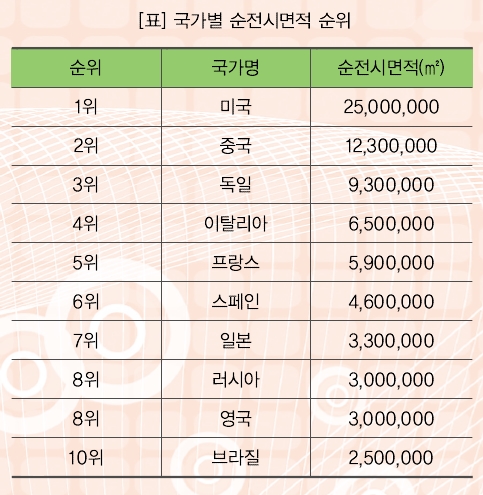 UFI가2009년에실시한순전시면적500㎡이상전시회현황조사결과에따르면, 2008년기간중전시회개최건수는 총 31,400건으로, 이들이 사용한 순전시면적은총 1억 9백만㎡인 것으로 나타났다. 이들 전시회가 유치한직접참가업체수는2백9십만개사, 참관객은2억6천만 명에 달한다. 국가별로 순전시면적을 비교한 결과 미국(2천5백만㎡), 중국(1천2백3십만㎡), 독일(9백3십만㎡)이차례로1, 2, 3위를차지하였으며, 상위10개국의순위는다음표와같이나타났다.
UFI가2009년에실시한순전시면적500㎡이상전시회현황조사결과에따르면, 2008년기간중전시회개최건수는 총 31,400건으로, 이들이 사용한 순전시면적은총 1억 9백만㎡인 것으로 나타났다. 이들 전시회가 유치한직접참가업체수는2백9십만개사, 참관객은2억6천만 명에 달한다. 국가별로 순전시면적을 비교한 결과 미국(2천5백만㎡), 중국(1천2백3십만㎡), 독일(9백3십만㎡)이차례로1, 2, 3위를차지하였으며, 상위10개국의순위는다음표와같이나타났다.
UFI는 전시회주최자 회원사를 대상으로의 관련 활동에 대한 몇 가지 트렌드를 정기적으로 조사하고 있다.2010년에 조사 분석한 결과에 따르면, 이들이 임차한 전체전시면적은2006-2007년중7% 증가, 2007-2008년중 5% 증가 등 지난 2년(2006-2009년) 간 지속적으로증가한 것으로 나타났다. 반면, 2009년에는 2008년 대비16% 감소를보인것으로분석되었다.
많은대규모전시회들이격년으로개최되는특성을감안하여, 2년 단위로 전시회활동을 분석해 본 결과,2006/2007년- 2007/2008년전시활동은6% 증가한반면, 2007/2008년 – 2008/2009년 전시활동은 6%로 감소한 것으로 나타나, 결과적으로 2008/2009년의 전시활동은 2006/2007년의 활동결과와 동등한 수준인 것으로분석되었다.
하지만, 이같은상황이모든지역에동일하게적용되는 것은 아니다. 아시아/태평양 지역의 경우 2006/2007- 2007/2008년기산중15% 이상증가하였으나, 미국과유럽지역에서는약간감소하는추세를보였으며, 중동및아프리카지역에서는소폭증가하는결과를나타냈다.
■ 전시주최자 현황(Exhibition organizers)
전시산업은 개최 규모별로 크게 다른 특성을 나타낸다. 2008-2009년 기간 중 UFI 회원사 중 전시주최자사업을 하는 기관은 평균 183개로, 전체 회원사의 90%이상이 주최사업을 수행하고 있는 것으로 파악되었다.86개사는 매년 총 5만㎡ 이하의 전시면적을 임차하고있으며, 15개 주최기관은 50만㎡ 이상에 달하는 전시면적을 임차한 것으로 나타났다. 한편, UFI 전시주최자 회원사의 72%는 자국 내에서 사업을 운영하고 있으며, 나머지 8%에 해당하는 회원사의 경우 타 지역에서사업 활동을 하고 있는 것으로 나타났다.
■ 글로벌 전시산업지표(Global Exhibition Barometer)
2011년 6월에 수행될 6차 지표분석 연구조사 결과는 지난 2008년 말 이후 전시산업에 미친 경제위기의 영향에 대한 인사이트를 제공할 것으로 기대된다. 전 세계적으로, 응답자의 60%는 2010년 상반기 동안 매출액 이 바닥을 친 후, 하반기 동안 상승세로 전향한 것은 부인할 수 없는 사실이라고 응답했다. 2010년 사업 수익성의 경우 2008년, 2009년과 비교하여‘10% 이상 상승하였다’는응답이 40%, ‘다소 안정적이었다(-10% ~+10%)’는 응답이 40%로 나타났다. 응답자의 70% 이상이 2011년 상반기 중 매출액 증가를 기대하며, 응답자의 60%가 경제위기의 여파로 인해 여전히 자사의 전시사업이 어려움을 겪고 있다고 응답하였다. 한편, 이조사 결과는 다음 그림과 같이 지역별로 상당한 차이를나타내고있다1).
향후 주목해야 할 이슈에 대하여 7개 항목 중 가장중요하다고 생각하는 항목 3개에 대해 순위 매기도록조사한 결과, 1위는 조사자의 23%(이 중 30%가 가장중요한 이슈라고 응답)가 응답한“국가 및 지역경제 상황”으로 나타났다. 2위는 조사자의 20%(이 중 10%가가장 중요한 이슈라고 응답, 지역차 큰 편)”가 응답한“내부적 관리 문제(예: 재정, 인적 자원, 지원인력, 훈련 등)”로 나타났다. 3위는 조사자의 19%(이중, 20%가가장 중요한 이슈라고 응답, 지역차 큰 편)가 응답한“불안정한 세계경제”로 나타났다. 그 외 다른 요소로응답자의 9%가 환경요인(예: 고객기대, 규정 등), 응답자의 6%가 다른 매체들과의 경쟁(예: 인터넷, 가상무역전시회, 소셜미디어 등), 응답자의 5%가 다른 매체들과의 통합성(예: 인터넷, 가상무역전시회, 소셜미디어등), 응답자의 2%가 기타(주로 국제시장의 경쟁) 등을꼽았다.
1) 2010년 상/하반기까지 아시아/태평양 지역 소재 기업의 매출액 증가율이 가장 높았으나, 2011년 이후에는 중동/아프리카 지역 소재 기업의매출액 증가율이 가장 높게 나타날 것으로 전망됨(편집자 주).
추후 이같은 조사는 2011년 6월에 실시될 예정이며, 결과는 2011년 7월 중에 발표될 것이다.
[영어 원문]
KEY FIGURES ABOUT THE GLOBAL EXHIBITION INDUSTRY
■ Background
UFI, the Global Association of the ExhibitionIndustry, has developed its research program withthe objective to provide reliable data on theinternational exhibition market to its members andto the general community interested in exhibitions.
Different projects are undertaken in order toprovide the required data which covers threelevels: the venues, the events held in those venuesand the companies who organize those events.
In addition, a “Global Exhibition Barometer”isproduced twice a year which assesses the keyeconomic results of companies from the exhibitionindustry (including turnover and operating profit).This trend survey was initiated at the beginning of2009 among UFI Members in order to assess theimpact of the “economic crisis”. The survey alsoincluded members from SISO (Society ofIndependent Show Organizers) in the USA andfrom AFIDA in Central & South America(Asociacion International de Ferias de America). InJune 2011, the data from members of EXSA(Exhibition and Events Association of SouthernAfrica) will also be included.
In addition UFI conducts “The Trade FairIndustry in Asia”report (in cooperation with BSG)and the “Euro Fair Statistics”, whose last editionlists the audited statistics of 2,092 trade fairs andexhibitions held in 2009 in 20 European countries.
■ A look at Exhibition venues
UFI’s “World Map of Exhibition Venues”, firstproduced in 2007, identifies exhibition venues witha minimum of 5,000 sqm indoor exhibition spaceworldwide.
1,062 venues were identified in 2006,corresponding to a total gross indoor exhibitionspace: 27.6 million sqm. At the time, projectedfigures for 2010 were 1,104 venues, cumulating 31.1million sqm of total gross indoor exhibition space:(+13% over the period or +3.2% per year onaverage). A new World Map of Exhibition Venueswill be released by UFI in November 2011.
In October 2010, UFI analysed the venueexpansion among its 188 Members who operateexhibition centres. Results show that among UFImembers, venues have increased their exhibitionspace by approximately 3% a year during the2006-2010 period. It was expected that this ratewould slow during the 2010-2012 period, with asmall 1% yearly rate increase.
Different regional trends are noted, with UFImember venue capacity in Asia/Pacific almostreaching a 50% increase since 2006. All otherregions showed a 10% increase in capacity.
■ Exhibitions & attendees
UFI released global estimates in 2009, related toexhibition events with a minimum of 500 sqm ofnet space. The market size, for the year 2008, wasestimated to represent a minimum of 31 400exhibitions per year corresponding to 109 millionsqm of total net exhibition space. It was estimatedthat these events would attract an estimated 2.9million direct exhibiting companies and over 260million visitors.
The 10 major national markets, in terms of total net square meters of exhibition space rented in2008, were: USA (25,0 million), China (12,3million), Germany (9,3 million), Italy (6,5 million),France (5,9 million), Spain (4,6 million), Japan (3,3million), Russia (3,0 million), UK (3,0 million) andBrazil (2,5 million).
UFI regularly produces some consolidatedtrends on the activities of its Members whoorganize exhibitions. An analysis conducted in2010, covering the 2006-2009 period, showed apositive trend in total space rented during the2006-2008 period (+7% between 2007 and 2006,and +5% between 2008 and 2007) which ended in2009 (-16% between 2009 and 2008). As manylarge events are biennial a better picture is seenbased on an average two year trends. In this casethe progression of 2007/2008 when compared to2006/2007 (+6%) has been neutralized by the dropmeasured in 2008/2009 (-6%) and as a result, the2008/2009 level of activity is equivalent to the oneon 2006/2007.
However, not all regions performed the sameway: the volume of exhibition activity inAsia/Pacific increased by more than 15% between2008/2009 and 2006/2007, whereas it decreasedslightly in the Americas and in Europe and onlyslightly increased in the Middle East and Africa.
■ Exhibition organizers
The exhibition industry is largely fragmented.Based on annual average numbers for 2008 and2009 provided by 183 UFI organizing companies(and their subsidiaries) who represent more than90% of the total UFI Membership activity, 86companies rent up to 50 000 sqm in total on ayearly basis. On the other hand 15 organizersrent more than 500 000 sqm. 72% of UFIorganizers operate in their own country only while15 UFI members (8%) operate in 3 or 4 regions.
■ Global Exhibition Barometer
The 6th barometer survey, conducted in June2011, provides an insight into the impact of theeconomic crisis on the exhibition industry since theend of 2008.
Globally speaking, a “bottom-out”effect for thedecrease in turnover occurred during the first halfof 2010 for around 6 respondents out of 10, whoalso declared an increase of their turnover for thesecond half of 2010. Their 2010 operating profitscompared to 2008 and 2009 increased by morethan 10% for 4 respondents out of 10 and remainedstable (between -10% and +10%) for another 4 outof 10. More than 7 companies out of 10 also expectan increase of their turnover during the first halfof 2011 but 6 respondents out of 10 consider thattheir exhibition business still suffers from theimpact of the economic crisis. However, there aresignificant differences across the various regionsof the world.
Companies were also asked to identify the threemost important issues for the coming year out of aproposed list of seven and the order is: the “Stateof the national/regional economy”(mentioned by23% of respondents and listed as the mostimportant issue for 30% of them), followed by the“Internal management challenges”(e.g. finance,human resources, staff, training) which wasmentioned by 20% of respondents and listed as themost important issue for 10% of them (but thisvaries greatly from one region to another) andfinally the “Global economic uncertainty”(mentioned by 19% of respondents and listed as themost important issue for 20% of them, but thatalso varies significantly from one region toanother).
Other issues identified were:“Environmental challenges (customer expectations,regulations, etc.)”which was mentioned by 9% ofthe respondents; “competition from other media(ex. internet, virtual trade shows, social media)”which was also mentioned by 6% of therespondents; “Integration with other media”(ex.internet, virtual trade shows, social media) wasmentioned in the top 3 priority by 5% ofrespondents and a remaining 2% chose “Other”,mainly specifying“ international competition”.The results of the next survey, conducted inJune 2011, will be released in July 2011.
For more information, please consult
www.ufi.org

